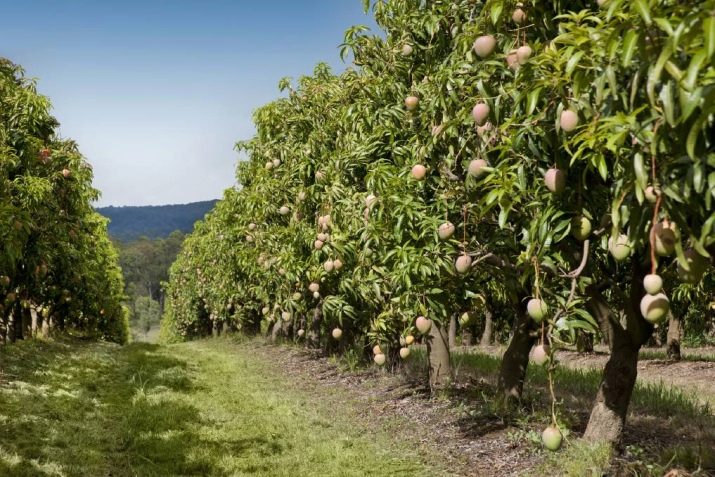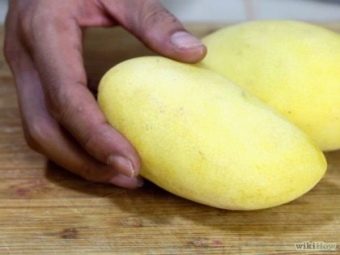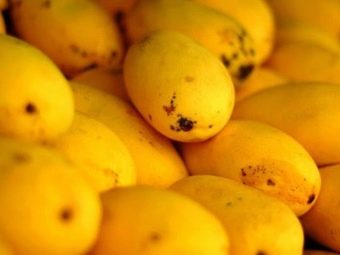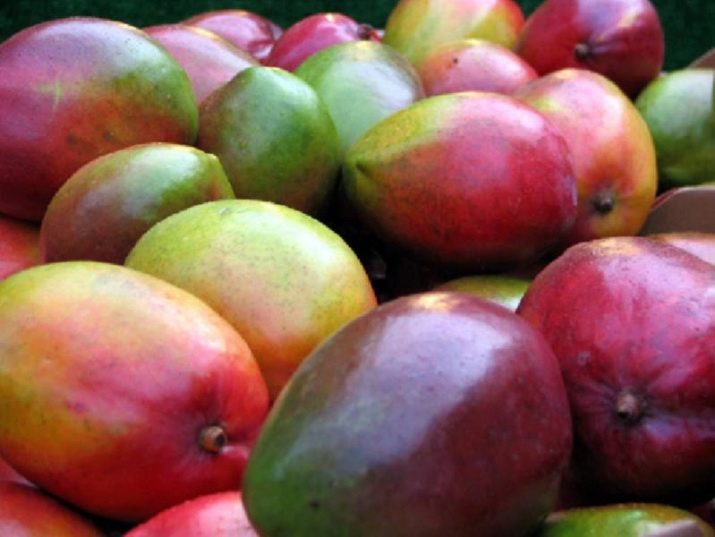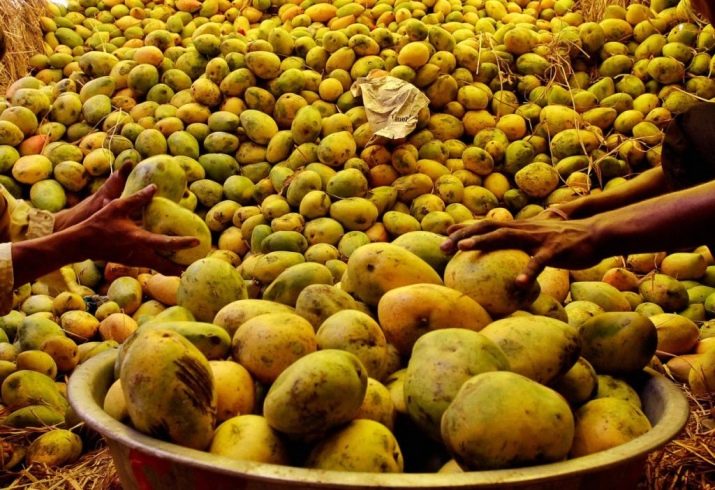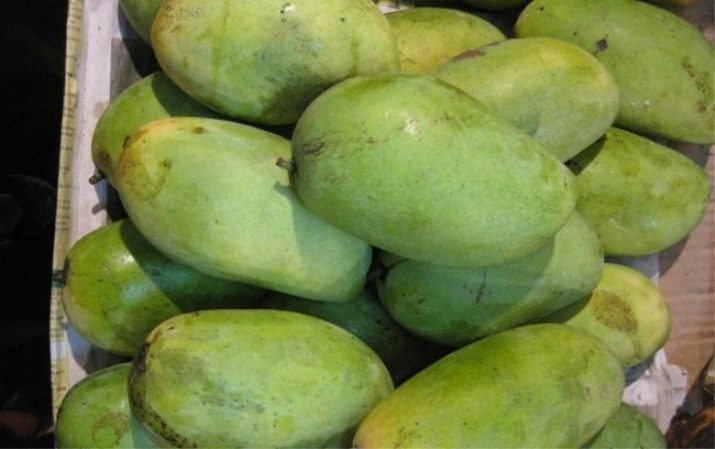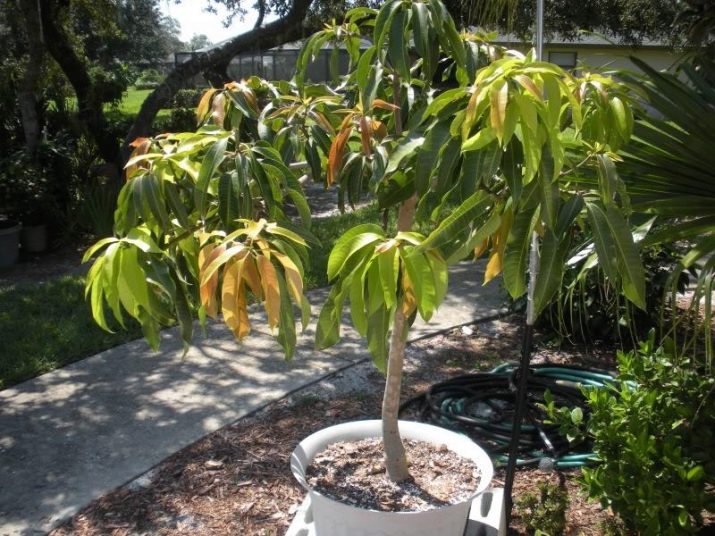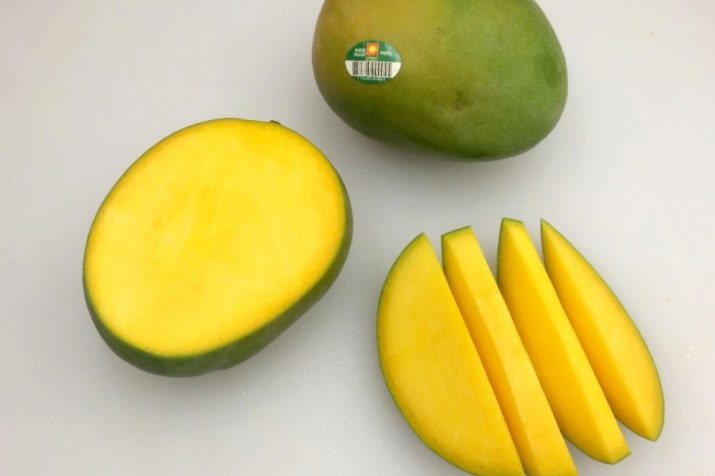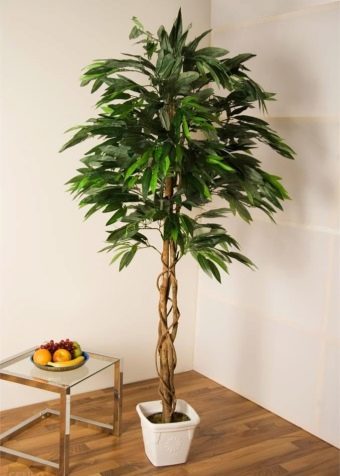Mango: varieties and characteristics of growth at home
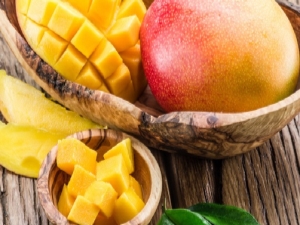
One of the most amazing and mysterious countries on the planet is India. The country of spices gave the world such a delicious fruit as mango. The fruits of the beautiful evergreen tree Mangifera indica have excellent taste and a lot of useful properties. These are valuable sources of vitamins A, C, B1, B2, E, essential amino acids and minerals. Today, the fruits of the Mango genus, belonging to the Anacardia family, have become almost the most widespread fruit crop grown in tropical latitudes, from which fragrant fruits are exported all over the world.
How does it grow in nature?
Mango's natural range is rather limited. His wild relatives can be found in Myanmar, whose area is almost half occupied by tropical rain forests, or in Assam - one of the states in eastern India. The area of distribution of cultivated plants is represented by almost the entire tropical zone and areas with suitable climatic conditions in the subtropics of both hemispheres.
Appearance
Mango tree is a long-lived, vigorous, evergreen fruit breed. Mangoes growing in nature look impressive, thanks to its huge spherical crown, whose diameter, as a rule, coincides in size with the height of the tree, ranging from 10 to 20 m.
In the Indian states you can find 30-meter long-livers giants 150-250 years old. During vegetative propagation, plants have more modest size, growing to a maximum of 800 m in the tropics, and do not live for so long. If they are cultivated in subtropical zones, the height of the trees is controlled, focusing on the sea level in a particular area.
Its attractive appearance of the mango is largely due to alternating leaves of lanceolate shape, reaching a length of 30 cm. The front side of the leaf plate has a rich green color, and the reverse is lighter. Young foliage color is red or yellowish-green.
How does bloom?
Although the foliage of mango trees lasts throughout the year, the shoots grow in a wave-like mode, so there is a direct connection between the rhythm of mangifera growth and the frequency of flowering. For some varieties, it is characteristic to bloom 2-3 or even 4 times a year, others are limited to one time. Specific forms from the South Indian subequatorial regions are characterized by year-round flowering.
Complicated pyramidal inflorescences in the form of long panicles up to 40 cm are formed from flowers of very small size (maximum diameter 5 mm) reddish or pale yellow. Each inflorescence can contain as several hundred flowers - about 200, as well as several thousand, sometimes about 4000 pieces. Most of the flowers are for men, the rest are bisexual. The number of the latter, depending on the variety may be 1-35% of the total number of inflorescences.
Ripening and fruiting
Only one or a couple of fruits ripen on one panicle, which is due to the low coefficient of the useful ovary of the mangifera (less than 1%). On some inflorescences the fruits do not ripen at all. At best, a high yield of grafted mango will please only a year later, which is why often a good harvest has to wait from 2 to 4 years. In the high-yielding year, fruit buds are not laid on mango trees, respectively, they do not bloom and do not bear fruit next year.
The weak ovary of the fruit is due to two main reasons - the short susceptibility of stigmas, the limited possibility of fertilization only a few hours and the precipitation, due to which pollinating insects stop working. In addition, with increased humidity increases the risk of fungal diseases, including anthracnose, which affects the flowers.
The ripening period lasts from 4 to 5 months.Depending on the variety, the sizes of the largest fruits are 22–25 cm in length, and 5–6 cm in small ones. Moreover, their form is very different:
- round;
- ovoid;
- curved;
- flattened.
On average, fruits weigh from 250 g to 1 kg. A lot of fruit also depends on the variety. On top of the mango are covered with smooth wax skin, which is cut with a knife to get to the juicy flesh. The hue of the internal fibers varies in color from light yellow to a rich orange color.
The peel has a white or green color with a slight blush. Often there are red spotted fruits. The core of the fruit contains a lamellar stone in a dense shell. The flavor range of ripe mangoes is quite wide - the fragrant flesh is both sugary-sweet, sweet-sour or pleasantly astringent, and frankly sour. The fruit also smells differently, recalling the aroma of peach, melon, lemon tree and even roses.
Root system
Mangifera is a tree with a powerful core root system located under the ground at a depth of 5 to 8 m. It is represented by suction roots that are located in the surface layers of the soil, going down to a depth of 1 m. Fruit trees often have a two-tier root system when the main root penetrates ground to a depth of 4 m. They settle near the groundwater, and the upper processes are located closer to the soil surface at a depth of not more than 0.8 m.
In climatic zones with a long drought season of up to 5 months, the mango tree is the only fruit crop that can withstand the absence of irrigation. mangifera can grow in the open sun and slightly shaded areas, the main thing is that the soil is well drained.
In cases where the soil is over-wetted or water stagnates during the rainy season, mango trees no longer bear fruit regularly.
Popular varieties
From the perspective of evolutionary theory, mango is an outdated variety of plants. In ancient times, its seeds were spread by giant sloths and an extinct species of proboscis - gomfoteriyami who ate the fruit completely, including the bone. For this reason, the trees fruited, focusing on the taste preferences of prehistoric animals. After their extinction among the representatives of the animal world there were no longer those who could spread the wild-growing fruits in the same productive way.
However, the mango was enjoyed by the people, and gradually, the fragrant fruit, which for centuries remained the leading fruit crop in India, Bangladesh and Pakistan, was learned in other countries. Even before our era (about 2500 thousand years ago), this heat-loving evergreen plant began to be cultivated in the countries of Southeast Asia (Southeast Asia), and 1,500 years later, in East Africa. Thanks to the Spanish navigators, mangoes fell into the territory of America, after which it was cultivated in Mexico, Brazil and the Caribbean islands.
Today, large-scale production of mangifera is conducted in India, Pakistan, Mexico, the Philippines, China and Brazil. There is no exact information about the number of cultivated varieties. Most sources claim that the existing varieties of the mango tree contain about a thousand forms. The most rich varietal variety of mangoes can boast of the countries of Southeast Asia, which geographically includes Bangladesh and the eastern parts of the Indian Republic.
Kinds
Based on the origin, there are two main varieties of the mango tree.
Indian Distinguishing features are young shoots of bright red color, rich coloring of fruits with regular shape, bone of relatively small size. Fully mature plants of this species can only in moderately moist soils, as they are contraindicated for excessive moisture.
- Philippine (South Asian or Indochinese). Features - the growth and fruits of elongated shape have the same greenish color. Representatives of this species are already lacking such pronounced intolerance to an excess of moisture, as in the Indian counterparts. They are resistant to extreme natural climatic conditions - drought, high temperatures, prolonged rains.
The Indian type of mangifera is the most ancient. Although now the Thai Mangoes are seriously competing on the world market for “Indians”, this phenomenon largely explains the fact that Thailand has recently become one of the most popular tourist destinations.
The Republic of India not only grows a large number of mango varieties (about 200 forms), annually supplying the market with up to 10 thousand tons of fruit, but also leads an active scientific selection. This makes it possible to obtain high-quality fruit-bearing varieties that can resist parasitic and fungal diseases.
Each variety is represented by a variety of varieties, differing not only in appearance in size, shape, shades of flowers, fruit color, but also in taste. Any other forms of mango are hybrid, that is, obtained by crossing plants, which belong to two main species.
Dwarf forms are usually used for commercial cultivation on an industrial scale and they are recommended to be used for breeding at home. Consider the varieties of both varieties of mango and hybrids that are most in demand by consumers.
Alfonso
Mango king Representatives of the most famous and expensive Indian variety, famous throughout the world for their delicate, literally melting in the mouth pulp with a creamy texture and sweet taste, slightly giving away saffron. But outside the fruit is very solid, covered with a dense skin, so that it is convenient to transport them. Weigh fruits on average from 0.15 to 0.3 kg. The main disadvantage of the fruit crop is the short harvest season. Large-scale production of the variety is carried out mainly in three states - Gujarat, Karnataka, Maharashtra.
Alfonso fruits a little more than a month, starting with the last days of March and ending with the coming of May.
Nilam
Cultivated in Pakistan and in almost all Indian states, distinguished by high yields. Fruits begin to trade in the period from May to June. The fruits are miniature with tiny bones. Their taste is astringent, and the aroma is pronounced, floral.
This variety has become famous throughout the world and is considered to be one of the best.
Dashary
Another popular variety of mangifera cultivated by the northern region of the Republic of India. As a periodically fruiting dessert variety with high-quality fruits, it is often used in breeding work, due to which many northern forms with valuable properties have been bred. The fruits have a rich color in juicy yellow-green tones and elongated, rounded over the entire length of the form. They have a sharp tip. The flesh is very sweet - with a touch of honey. The presence of a peculiar sharpness and sourness makes the taste more piquant and refined. Fruits all summer, so the harvest is collected from June to August.
Kent
This hybrid variety is the pride of American breeders. Its cultivation is mainly engaged in two states - Miami and Florida. Differs in good transportability, long storage period, high yield, resistance to diseases. Fruits of light-green color, rosy from the sunny side. The taste is amazing, and the tender flesh is almost fiber-free. The harvest season is long - mangoes are harvested throughout the summer.
Kesar
Commercial cultivation is practiced in Gujarat with a tropical climate in the northwestern state of Hindustan. Fruit picking takes place from June to July.The reasons for the popularity of this variety lie in the magical aroma that spreads during the cutting of fruits, and in their perfect taste - sweet with sourness. And they often look rather inconspicuous, having a modest size, irregular, rounded shape and yellow skin, often with dark spots.
However, the unattractive skin hides the unusually juicy flesh of rich yellow color, the taste qualities of which more than compensate for any deficiencies in the appearance of the mango from Gujarat.
Makhachanok
Mangoes of this variety are cultivated by Thailand. They are in most cases found on the shelves of our supermarkets. Ripe fruits, covered with a smooth thick skin, under which lies a juicy flesh, have a pleasant taste with the presence of a characteristic coniferous note. The fruits are oblong in shape and weigh from 200 to 350 g.
Langres
Representatives of this variety are valued not only by residents of the northern states - Haryana, Bihar, Uttar Pradesh and the state in eastern India (West Bengal), where it is grown on an industrial scale, but also by tourists. The secret of their popularity lies in the strong aroma and very delicate, sugar pulp. The shape of the fruit is round and elongated. Externally, fruits may differ in color and degree of elongation of the fruit - large mangoes have a more elongated shape, these characteristics have no effect on the taste.
The harvest season is very short and lasts only two weeks in July, which confuses the lovers of mango varieties of Langres a little.
Sindri
This is the national treasure of the Islamic Republic of Pakistan. The variety is cultivated in Sindh, one of the provinces of Pakistan, which explains its name. The period of collecting fruits from June to July. A key feature of the representatives of this popular form is the exceptional sweetness of the fruit, so they are known among the aborigines as honey mangoes. Fruits are elongated, slightly crooked, the skin is uniformly colored, there are no spots.
Due to too tender pulp, the fruit cannot be stored for a long time.
Features of growing
Is it possible to grow an Indian mango tree at home at all? This is a question that amateur growers often get puzzled with. After all, for a true exotic, growing in the tropics and subtropics, landing in open ground is absolutely not acceptable. Especially if you consider the temperate climate in most regions of Russia.
To realize our plans at home, you will have to take into account the agrotechnology of a heat-loving plant, create certain environmental conditions, and have time and patience. However, the end result is worth it. And although it is not necessary to wait for a large harvest from a home plant, a fructifying tree with even several fruits is highly decorative and will occupy a worthy place in the collection of home plants.
Some sources believe that in our country the most suitable places for mango cultivation are the southern regions of Stavropol and Kuban, where climatic conditions are favorable for the ripening of cold-resistant forms. According to the statements of specialized publications, this can be safely argued, since lowering the temperature to the minus 5 ° C mark is a real disaster for people from the tropics. He is unlikely to survive such a cold.
There are two ways to become an owner of your own mango tree. The easiest way is to purchase a ready seedling by contacting a nursery or a botanical garden, after which it remains only to move it into a container with a suitable soil mixture, providing appropriate care. Another method involves seed reproduction of exotic plants, which would require the bones of high-quality, ripe fruit. But in this case, you will have to be content solely with obtaining only an ornamental plant with elegant foliage, giving it a resemblance to a palm tree.
The ability to bloom and fruiting is inherent only in vaccinated specimens from nurseries.Although if you resort to budding - self-replanting the stock of a varietal plant on the stock, in a couple of years the grafted mango from the stone will bloom, and after 3 months you can enjoy the sweet taste of fragrant fruit.
Seed preparation
When determining the degree of ripeness of the mango, the color of the skin is an insufficient reference point. Coloring in this case only confuses, as the mature fruit can equally hide under the skin of any color. Therefore, choosing fruits, they are slightly squeezed. The ideal candidate for planting is resilient, but not too firm to the touch, with a smooth matte skin, covered with a waxy coating. Any damage on the outer shell is not allowed.
Ripe fruits can be identified by a pronounced fruit aroma, slightly giving away with turpentine, but not with alcohol - this is how over-ripe mangoes, which could have already fermented, smell. Another sign of ripe exotica is an ossicle that separates easily from the pulp.
For home sprouting bone mangifera need to adhere to several rules.
- Cut off the peel from the fruit, carefully cut it in half, remove all the flesh with a knife from the lamellar core extracted from the fruit core.
- Rinse it thoroughly in water and ensure the integrity of the shell.
- Extract the seed from the nucleus - this will accelerate the formation of the embryo. The surface of the ripe bone, which resembles externally the bivalve mollusk, is speckled with natural cracks, facilitating the opening of the valves with kitchen scissors or a knife.
- Attempts to break a stone with a very hard shell can cause injury to the seed. It is better not to risk, but to take a transparent vessel, pour water into it at 20-25 ° C and place an impregnable core there. Capacity to leave for a couple of weeks in a warm and well lit place. To prevent flowering or stagnation of water, it must be changed every two days. After waiting for the allotted time, the swollen bone will remain open on the side and extract the contents.
- You can disinfect a seed using any of the biological fungicides. Young seed, which has lost its protective shell, becomes extremely vulnerable to mold fungi, so you should not neglect the sanitization.
- Wrap the seed in a wet, but not too wet and always breathable material. The future seedling is contraindicated in excess moisture and air deficiency. And that, and another contributes to rotting.
- Create conditions like in a greenhouse. Wet matter with seeds will need to be placed under a dense plastic film. To solve this problem it is very convenient to use a zip-package or food container.
- Put a mini-greenhouse in a dark place, not forgetting the need to control the humidity once a day.
To germinate a seed in room conditions, you can use a container with coconut or organic soil substrate made of peat moss. The seed extracted from the fruit is placed in the wet mixture for several weeks. As soon as the embryo appears, it will be possible to transplant it into the soil.
Landing
The success of growing exotic plants depends largely on the correct choice of planting mixture and pot. Mango feels well in the finished universal neutral earth mixture (pH in the range of 6-7) for indoor deciduous crops. Since in their natural habitat the roots of plants go deep underground, it is advisable to immediately take care of a roomy pot for mangifera in order to ensure the free growth of the aerial and underground parts of the plant.
The presence of a spacious container eliminates the need for frequent transplantation of a seedling, in which its roots may also suffer. Tropical fruit trees, including many varieties of mango, are contraindicated for stagnant water and an excess of moisture, so the pot should be with several drainage holes.
You must comply with the algorithm of action.
- The formation of a drainage layer with a thickness of 6 cm at the bottom of the container. For these purposes, you can use the rubble of fine fraction, crushed foam, vermiculite granules or perlite. Drainage not only removes excess moisture, which provokes rotting of the root system, but also contributes to the normal root respiration of the plant.
- Filling the pot with earth mixture passes to the edges by 1/3. In the case of using a homemade substrate, it is necessary to check the degree of alkalinity. This can be done as a special device for measuring soil pH, and disposable indicators.
- Planting seeds. If a seed has slit, then it is carefully deepened into the ground on ¾ by the part on which the embryo was formed. When germination did not give a result (that is, there is no root), then when planting, the seed is placed sideways in the hole, since visually determining the top and bottom parts is rather problematic.
In both cases, the tip of the seed must peek out of the ground to ¼ of the part. Planted seed must be plentifully watered with soft water t 22-25 ° C.
Mango tree is a thermophilic fruit crop, for which it is necessary to create a certain microclimate.
- The planted seed is covered with a cut-off PET bottle, plastic wrap, a convex glass lid or a container made of transparent plastic.
- Regularly raise the covering structure to check the condition of the plant, watering and ventilation.
- Place the pot in a warm place with sufficient natural light. The best option is a windowsill, if the windows in the room are oriented to the south or south-west side.
The appearance of the sprout of mangifera after 2-3 weeks is a reason for removing the greenhouse protection, so as not to limit the development of the stem in height.
Top dressing
A sapling of a mango tree, as well as any plant that receives vital macro- and microelements from the soil, requires systematic feeding. A tender tree is sensitive to any chemistry, therefore it is fed exclusively with organic fertilizer mixtures. For proper growth you need humus, which is regularly placed in a shallow groove made around the stem of the plant, and then sprinkled with a little soil.
In order for the foliage to retain an intense green color, monthly it will be necessary to resort to the use of unilateral nitrogen-containing fertilizers. If we neglect the nitrogen nutrition, then due to a decrease in the content of chlorophyll, the leaves become light green. The leaf blade will begin to decrease in size. The rate of shoot growth decreases.
When deciding to plant an exotic plant, it will need to be fed on a permanent basis with nitrogen fertilizers. Especially if the tree blooms and begins to bear fruit.
Care
Many amateur breeders explain the refusal to grow mangife at home by the strict requirements of this exotic to the conditions of detention. However, taking care of the Tropican is not that difficult. It, like any plant, must be placed in the right place, watered, fed and transplanted in a timely manner.
Light mode
If for many green pets exposure to direct sunlight is extremely undesirable and even destructive, then mango, on the contrary, favorably perceives an abundance of sunlight. An ideal place to place a pot with this exotica is a well-lit window sill. Dark corners and places in the back of the room do not suit him.
Restricting access to light provokes "leaf fall" and leads to the death of thermophilic fruit culture. Without a full 12-hour daylight, the guest’s well-being from the tropics deteriorates, so with the arrival of winter, it has to be artificially illuminated with an LED phyto-lamp or a gas-discharge light source — a fluorescent lamp.
Temperature conditions
Mango trees react negatively to any changes in climatic conditions.The maintenance of the house mangifers implies the need to ensure that the mark on the thermometer is kept at + 22 ... + 26 ° C. For this reason, it is undesirable to put pots with trees on the loggia or terrace in the country, even if it is summer outside.
The health of a thermophilic culture can be shaky due to a sudden gust of wind or rain.
Moisturizing mode
Exotic tree is contraindicated content in a room with dry air. The problem is solved by the use of a special climate device - a humidifier. You can also pour water into several containers and put them in close proximity to the pot. The relative humidity of the air is not less than 70%.
How to water?
Dry soil is also unacceptable for mangifera. The recommended frequency of watering 2-3 times a week, depending on the microclimate in the house (humidity, temperature). However, it is impossible to re-moisten the earth, since excessive moisture is harmful to the roots. It is permissible to use only distilled water t 20-25 ° C. The leaves need to be systematically sprayed.
How to form a beautiful crown?
Crone mango needs regular care, except when the owner’s plans include organizing a greenhouse in the house. Pinch the top when the seedling will give the eighth leaf. When a tree reaches one and a half meters height (which takes about a year from the moment of planting), you can proceed to the formation of the crown. This contributes to its uniform development and allows you to maintain an attractive compact form.
Pruning is recommended in the spring months. The trees quite calmly carry this procedure. After trimming, only the main branches should remain on the trunk. It is necessary to get rid of old branches or crown growing inside, and shorten the length of fast-growing shoots. For the treatment of damaged areas using garden putty to prevent possible infection or rot.
Transplant rules
In contrast to pruning to a transplant, capricious exotus is much worse when experiencing real stress. Even when a small-sized container was used for planting a seed, it is highly undesirable to disturb the sprout that appeared by transplanting into a larger container. In general, it is better not to touch this question during the first year of mango life, which needs to be rooted and gained strength. Mangifere update the pot as it grows, but no more than 1 time in 3-4 years.
The most favorable time for transplantation is the period from May to June.
Useful tips
Experts in the field of growing plants in the home environment made a list of recommendations.
- After each watering, the soil must be loosened to avoid oxygen starvation, which greatly slows the growth of the seedling.
- Often grafted mango trees are trying to bloom, being very young. In such cases, it is better to give the flower whisk to start blooming, removing it only when the first flowers open. Otherwise, exotic will attempt to bloom to infinity.
- At the first fruiting of mango it is recommended to leave fruits in a minimum quantity. The presence of the optimal number of ovaries on a tree aged 1-2 years helps to obtain tasty large-sized fruits. In addition, premature depletion of the plant can be avoided in this way.
Despite the fact that trees are quickly restored after pruning, it should not be abused. This is especially true for vaccinated exotic animals. Having formed the structure of the crown, this procedure is desirable to reduce only to the removal of dry branches. Due to excessive pruning, the yield of mangifera often drops. This is at best. At worst, fruit may not be seen for several years.
In the next video you can clearly see the process of growing mangoes at home.


